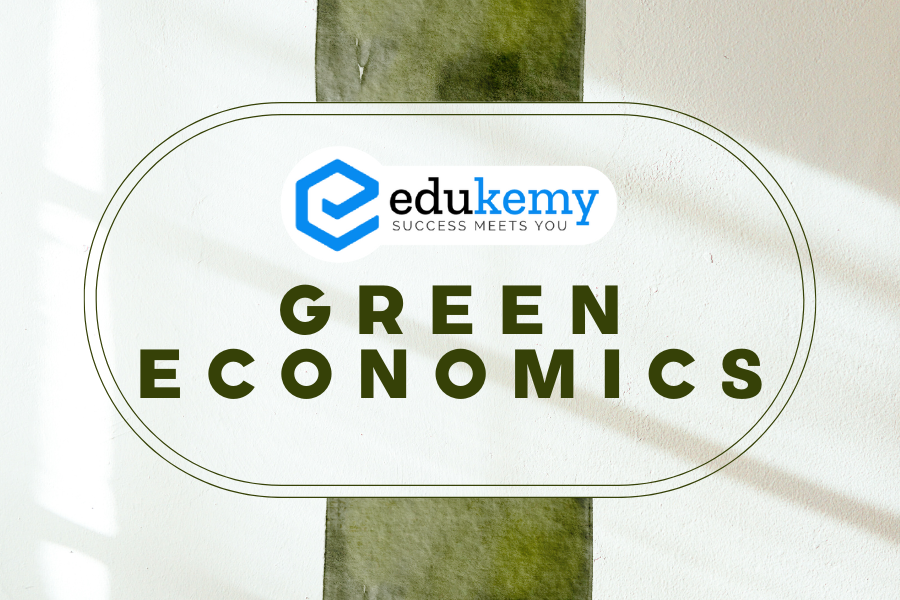
Green economics is a school of thought within economics that emphasizes the importance of sustainable and environmentally friendly economic practices. It addresses the critical issue of balancing economic growth with environmental preservation, aiming for a harmonious coexistence between humans and nature. Here are some key aspects of green economics:
- Environmental Costs of Economic Growth: Green economics recognizes that traditional economic growth often comes at a significant environmental cost. This includes pollution of air, water, and land, leading to threats to human health and well-being. Unsustainable growth practices deplete natural resources and can result in long-term productivity losses.
- Sustainability and Inter-Generational Equity: The concept of sustainability lies at the heart of green economics. It advocates for development that meets the needs of the present generation without compromising the ability of future generations to meet their own needs. This principle is also known as inter-generational equity.
- Historical Warnings and Reports: Early warnings about the challenges of sustainability can be traced back to Thomas Malthus’s “An Essay on the Principle of Population” in 1798. The “Limits to Growth” report commissioned by the Club of Rome in 1972 further highlighted the threat of unsustainability. The Brundtland Commission’s report “Our Common Future” in 1987 provided a widely accepted definition of sustainable development.
- Integration of Climate Change in Economic Analysis: Green economics recognizes the urgent need to address climate change. William Nordhaus, a Nobel laureate in Economic Sciences in 2018, was honoured for his work in integrating climate change considerations into long-term macroeconomic analysis.
- Triple Bottom Line Approach: Green economics promotes the concept of the triple bottom line, which focuses on sustaining and advancing economic, environmental, and social well-being. This approach emphasizes that economic success should not come at the expense of environmental degradation or social inequality.
- New Metrics for Measurement: To advance the green economy, new metrics for measuring progress have been developed. Examples include the Green GDP, Social Progress Index, and Environmental Performance Index (EPI). These metrics provide a more comprehensive evaluation of economic performance, considering environmental and social factors.
- Global Initiatives: International initiatives like the Millennium Development Goals (MDGs) and Sustainable Development Goals (SDGs) advocate for green economics. These goals set targets for achieving economic prosperity while safeguarding the environment and promoting social equity.
Green economics represents a critical shift in economic thinking, emphasizing the imperative of sustainable practices for the well-being of both present and future generations. It calls for a reevaluation of economic systems to ensure that growth is achieved in a way that is environmentally responsible and socially inclusive.
FAQs
1. What is Green Economics?
A: Green Economics is an economic theory and practice that emphasizes sustainability, social justice, and environmental protection. It advocates for policies and practices that prioritize the well-being of both people and the planet, seeking to reconcile economic growth with ecological limits.
2. How does Green Economics differ from traditional economics?
A: Traditional economics often focuses solely on maximizing economic growth and efficiency, often at the expense of environmental degradation and social inequality. In contrast, Green Economics takes a holistic approach, considering the interconnectedness of ecological, social, and economic systems. It promotes alternative indicators of progress beyond GDP, such as the Genuine Progress Indicator (GPI), which accounts for environmental and social factors.
3. What are some key principles of Green Economics?
A: Key principles of Green Economics include:
- Ecological sustainability: Prioritizing the preservation of natural resources and ecosystems for future generations.
- Social justice: Ensuring fair distribution of resources and opportunities, and addressing issues of poverty and inequality.
- Participatory decision-making: Involving communities and stakeholders in the decision-making process to ensure democratic and inclusive governance.
- Circular economy: Promoting resource efficiency and minimizing waste by designing products and systems that can be reused, recycled, or repurposed.
4. How can Green Economics be implemented in policy and practice?
A: Implementation of Green Economics involves a range of policy measures and initiatives, such as:
- Environmental regulations and taxes to internalize the costs of pollution and resource depletion.
- Investment in renewable energy and green infrastructure to reduce reliance on fossil fuels and promote sustainable development.
- Support for sustainable agriculture and conservation practices to preserve biodiversity and soil health.
- Education and awareness-raising campaigns to promote sustainable consumption and lifestyles.
5. What are the potential benefits of adopting Green Economics?
A: Adopting Green Economics can lead to numerous benefits, including:
- Enhanced environmental quality and resilience to climate change.
- Improved public health outcomes through reduced pollution and exposure to toxins.
- Greater social equity and inclusion, as policies prioritize the needs of marginalized communities.
- Long-term economic stability and resilience by avoiding the depletion of natural resources and minimizing environmental risks.
- Enhanced quality of life and well-being by prioritizing non-material values and holistic measures of progress.
In case you still have your doubts, contact us on 9811333901.
For UPSC Prelims Resources, Click here
For Daily Updates and Study Material:
Join our Telegram Channel – Edukemy for IAS
- 1. Learn through Videos – here
- 2. Be Exam Ready by Practicing Daily MCQs – here
- 3. Daily Newsletter – Get all your Current Affairs Covered – here
- 4. Mains Answer Writing Practice – here

